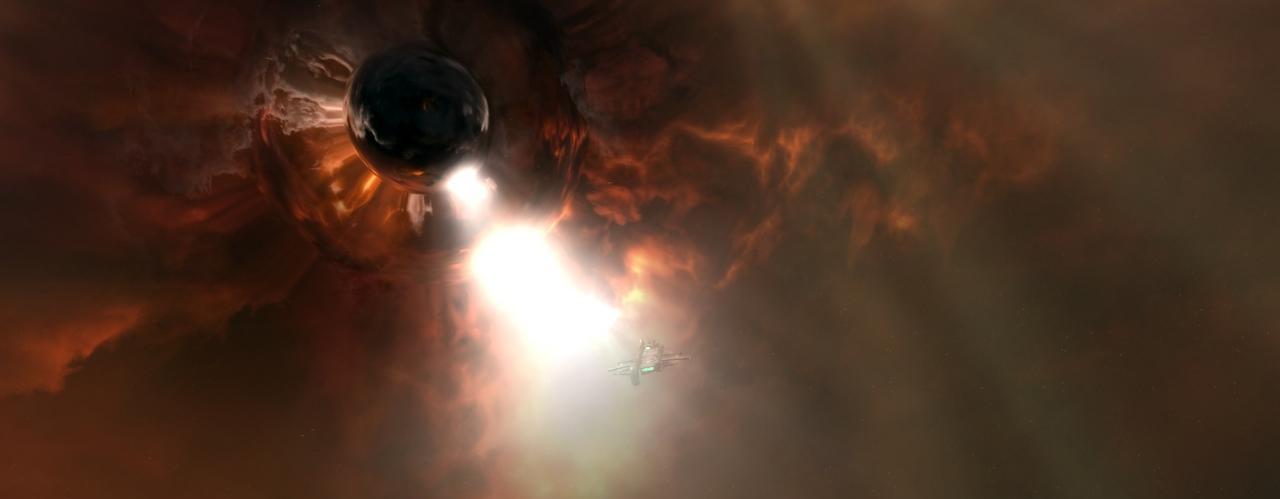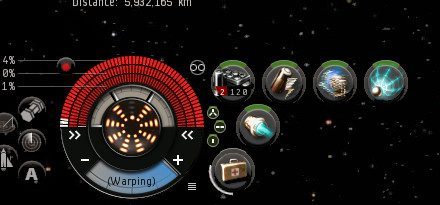Most EVE Online pilots stay in the (relative) safety of known space; those systems which appear on thestar map and are regularly connected by stargates. The map of New Eden is relatively unchanging, with systems always linked to neighboring systems in the same configuration. Not so with wormholes, which lead to all sorts of unknown and unexpected starsystems.
Wormholes can appear at random in any system, and can connect any two systems together, whether they be high security, low security, nullsec, or any combination thereof. Most importantly, they can lead to the mysterious wormhole space, which is the focus of this guide. Exploring wormholes and living therein can be a costly and challenging endeavor, but the rewards are certainly worth the risk, with millions and billions of ISK of opportunity to be found inside these lawless reaches of space.
Wormholes are a veritable playground for gankers and other PC pirates, so stealth, defense, and flying in fleets is essential. An constant adage in EVE is “don’t fly with anything you can’t afford to lose,” but this advice is doubly true for wormhole space.
To reduce confusion, the following terms will be used throughout this guide:
Wormhole: the physical, in-space entrance to a new system
Wormhole Space: uncharted systems that are only accessible through wormholes
Finding Wormholes
Wormholes are always found through exploration, requiring a pilot to use probes to pin down its exact location. This is not a probe scanning guide, but knowledge of their use is essential for anyone wishing to make a living exploring these unique systems.
Each race has a frigate designed with scanning in mind as well as a higher-tier covert ops-class ship with even greater bonuses and abilities. Use of these ships when trying to find wormholes or when initially exploring new wormhole space is highly recommended.
Minmatar: Probe, Cheetah
Caldari: Heron, Buzzard
Gallente: Imicus, Helios
Amarr: Magnate, Anathema
Appearing as “Unknown” cosmic signatures, when you have attained a strong enough scan signal it will be listed as “Unstable Wormhole.” When warping to a wormhole it is very important to bookmark it after you land on grid; your scan will put you some distance away from it and slow-boating to an entrance is a good way to get killed.
Additionally, make sure to bookmark the other side of the wormhole after you cross through – you never want to have to re-probe just to find the exit, particularly when being chased by angry wormhole space inhabitants or hostile players!
Wormhole Attributes
Jumping through a wormhole is much like jumping through a stargate; your ship rockets through space and arrives in a new place. You receive the same 10-second session change timer and one-minute gate cloak as normal, but there are distinct differences which are important to outline:
Distance: You will spawn at a variable distance from the wormhole, primarily dependent on the mass of your ship; smaller ships spawn closer, larger ships arrive farther away. Wormholes can be interacted with from a distance of 5km.
Polarization: No ship can jump through a wormhole in the same direction a second time within 5 minutes; if you entered system B from system A, you could not make the same trip within the next five minutes. This also applies to traveling the other way; in short there is a 5 minute timer if you change your mind after turning around once already.
Each wormhole has several specific properties, some of which change with time or in-game events. They give detailed clues as to where the wormhole leads, but the only way to be sure is to jump through and find out. Be warned that some corporations regularly put interdictor bubbles around the entrances to their wormhole space, hoping to catch unsuspecting explorers.
Most of these attributes can be found by right-clicking the wormhole and selecting “Show Info.”
Destination
While never being exact, each wormhole will detail the type of space it leads to in order to give explorers abetter idea of the dangers that await them. Wormhole space is designated Class 1 through Class 6, with the higher class yielding much deadlier, but lucrative, space.
Each designation begins with “This wormhole seems to lead into . . . “
- Unknown parts of space — this wormhole leads to Class 1, 2, or 3 wormhole space
- Dangerous unknown parts of space — this wormhole opens up into Class 4 or 5 wormhole space
- Deadly unknown parts of space — trough this entrance is a Class 6 system; be very cautious!
You can also receive a result telling you that the wormhole leads to high-security, low-security, or null-security space. The endpoints of these types of wormholes can lead anywhere in New Eden, perhaps dozens of systems away from the origin, or more.
Wormhole Name
Every wormhole has an “entrance” side and an “exit” side. When investigating a wormhole, if it appears asK162 on your overview, you have discovered an exit, which provides little to no information as to the type of space it connects to.
If the wormhole instead reports as the letter “A” followed by three numbers, you have discovered the entrance side. There are many websites and guides online that can tell you a great deal about the destination system based on the wormhole’s name, and it is always advisable to look up your target before jumping through, if possible.
Wormhole Lifetime
All wormholes have a variable lifetime before they dissipate, normally between 16 and 36 hours. Even if nothing else closes the wormhole they will fade into the ether after this timer runs out. Wormhole lifetime readings are given as follows:
- Life cycle has not begun — you have found a wormhole that has not spawned yet, but will appear within the next 5 minutes
- Should last at least another day — the wormhole is likely to last a while, possessing at least 50% of its remaining time
- Probably won’t last another day — the wormhole has at least 25% of its natural lifetime remaining
- Reaching the end of its natural lifetime — the wormhole has less than 25% of its regular lifetime remaining, and collapse is imminent
Unless you know what you are doing, it is not advised to enter an unknown wormhole when it is reaching the end of its lifespan, as it could collapse behind you, requiring that you find a new way home.
Wormhole Jump Limit
Each wormhole has a specific limitation to the size and type of ship that can pass through it. In general most wormholes allow battlecruiser and smaller-class ships through, but occasionally some can be found that permit battleships or even small capital-class ships through.
The specific limit is not so easily defined, but is rather given as a number of kilograms that can make the trip. A hypothetical 300 million kg limit would easily allow any battleship but a 20 million kg limit may limit entry to battlecruisers and below. Occasionally wormholes are limited such that only frigates and destroyers can go through.
Wormhole Mass Limit
Every wormhole has a fixed amount of starship mass that can pass through it, regardless of the number of jumps. Each jump made through a wormhole will subtract that ship’s mass from the remaining total until it runs out and closes. Even if a wormhole has only 1 kilogram remaining any ship that can fit through it’s jump limit can pass, closing it behind them.
Armour plates and propulsion modules increase a ship’s mass, and so it is highly recommended for those wanting a wormhole to stay open to offline those modules before traversing. A heavy interdictor can fit a Warp Disruption Field Generator which actually reduces the effective mass of the ship while online.
- Not yet significantly disrupted — this means the wormhole is stable with more than 45% of its full mass limit remaining
- Reduced, but not to a critical degree — the wormhole has less than 45% of its limit left, but it is not in danger of immediately closing
- Critically reduced — beware any wormhole that reports this status as it has less than 5% of its limit left and is primed for immediate collapse
It his highly encouraged to not enter wormholes which report criticality; the chance to be stuck on the other side is simply too great, and it is unlikely your probe ship will have the resources available to handle the dangers inside without backup.
A well-traveled wormhole is also likely to be home to an existing corporation or group of raiders who have been using that entrance; another reason to leave such spaces alone.
Collapsing a Wormhole
Whether a wormhole collapses due to its natural lifetime expiring or by its mass limit being exhausted, once it disappears several things can happen. If the wormhole was in regular known space, that’s the end of it –the wormhole disappears. Inside of wormhole space however, things get more complicated. The specifics of w-space wormholes is explored in a later section.
There are several reasons one may wish to intentionally close a wormhole, but the most common is to change where wormhole space exits to. If a corporation finds a wormhole in their space, or those who live in wormhole space find that an exit leads to notorious systems, they may intentionally drive massive ships through the entrance until it collapses.
This ends Part 1 of my EVE Online wormhole guide, first published online in November of 2016 for friends and new players alike. Part 2 will be published next week and then I’ll see about continuing to post my various guides and reviews on a regular schedule moving forward.
Please note that four years has passed since I wrote this (and other) guides, and so some, or even much, of the game has changed in that time. It’s not my fault if blindly following my advice gets your ship blown up!
Header picture taken from EVE Online gameplay.














